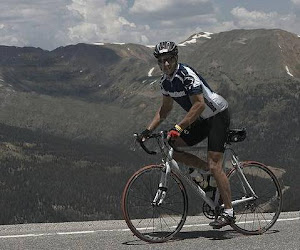Courtesy of Strava:
STRAVA Metrics Explained
What is Suffer Score?
Suffer Score is one of
Strava’s premium features and there’s something satisfying about putting
your feet up at the end of a tough day in the saddle and seeing an
‘extreme’ score. But what exactly is a Suffer Score and how is
it calculated?
In a nutshell, Strava’s Suffer
Score tells you how hard your ride was. Of course, that bit may be obvious,
but what isn’t obvious is why you might go out with a friend on the same ride
and come home with different Suffer Scores. Surely you’ve both done exactly the
same ride?
The explanation lies in
how the Suffer Score is calculated – it’s personal to you as a rider and is based
on your heart rate during a ride. Needless to say, you need to be wearing a
heart rate monitor.
The first thing Strava
will do is find your maximum recorded heart rate. From this it will calculate
your individual training zones. You can find these under the My Performance tab
in the Settings menu, where you can also set your custom training zones – the
most accurate way to calculate your Suffer Score.
Strava then associates a
value (or co-efficient) to each zone – the higher the zone, the higher the
value, and this value represents how many Suffer Score points you will score
for one minute in that zone. For example, one minute in zone one may accumulate
half a Suffer Score point, whereas one minute in zone five may accumulate ten
points. At the end of a ride Strava adds up the total amount of time in each
zone and multiplies it by that zone’s co-efficient. Add all these scores
together and you have your personal Suffer Score.
This explains why two
riders doing the same ride may come home with very different Suffer Scores. If
one rider is a lot fitter than the other then the fitter of the two riders will
likely be riding in a lower heart rate zone, and so will be accumulating less Suffer
Score points through the ride.
However, Suffer Score
does have its limitations. For example, if you were to do a short time trial,
say five miles, you might be riding for anywhere between 10 and 15 minutes.
Because the duration of the ride is short, there isn’t a lot of time to
accumulate Suffer Score points even though you’re working in high heart rate
zones. Therefore, if you did a very gentle two-hour ride you might actually
accumulate as many Suffer Score points as you did in the time trial. Suffer
Score, therefore, isn’t always a fair reflection of how hard you went or how
tired you will feel the next day, and is best used in conjunction with other
Strava features.
That said, Suffer
Score can still be a useful way to track your training. For example,
if you do the same ride every week then as you get fitter you should see the
Suffer Score start to come down. As you get fitter your heart rate is lower for
a given intensity, so if your score in December for the club run was 200 but by
March it’s down to 180 then you know you’ve had a good winter, though it’s
worth bearing in mind there are various other factors that can affect your
score.
Similarly, if your
Suffer Score for a ride seems unusually high then that could be a sign that
your heart rate is abnormally elevated. This could be the warning sign of an
oncoming cold and, therefore, it might be a good idea to back things off for a
few days.
For an even greater
insight into your training the scores you generate on each ride can be tracked
over time using Strava’s Fitness/Freshness graph.
What
is Weighted Average Power?
Weighted Average Power is a key figure that you’ll see at the end of each ride if you
use a power meter and is very similar to what people often refer to as
normalized power – the metric used in Training Peaks’ software. The idea behind
Weighted Average Power is that average power alone doesn’t tell the whole story
of a ride.
For example, if you do
a three-hour ride at a constant 150 watts, this (depending on how powerful you
are, of course) may be a gentle ride and not leave you too tired. Now, imagine
on the next ride you put out a constant 100 watts for the first hour and 100
watts for the last hour of the ride but in the middle you ride for one hour at
250 watts. The hour effort in the middle may leave you feeling pretty
tired and you then have to ride on for another hour, so it’s clear the second
ride would be much more fatiguing than the first ride but this wouldn’t be
expressed in the average power – 150 watts for both rides.
This is where the
Weighted Average Power comes in. As your power goes up, the amount of effort it
takes to sustain that power goes up by an even greater amount. For example 300
watts feels more than twice as hard as 150 watts and so Weighted Average Power
gives more authority to higher power outputs than lower, while it also looks at
the variation in power on your ride and calculates an average power which is a
more accurate indicator of your effort and, therefore, represents much better
how hard the session was physically.
For the first ride in
our example, the weighted average would be 150 watts, whereas for the second
ride the weighted average would be 192 watts. As a result, Weighted Average
Power provides a much better estimate as to how hard a ride was than average
power alone.
What
is Intensity?
If you use a power meter then, along with Weighted Average Power, you’ll also see
two other figures when you upload your ride to Strava: Intensity and Training Load.
Training Load we’ll come on to but first Intensity. This
metric compares the Weighted Average Power of your ride to your Functional Threshold
Power, which you can put into Strava on
the My Performance page under Settings.
FTP is the maximum average power you are able to sustain for
one hour (here’s how to
calculate your FTP). Therefore, if you go out and do a
25-mile time trial in one hour then you would expect your intensity to be 100
per cent if you pace your ride correctly and empty the tank. If, then, the next
day you decide to treat yourself to a nice easy ride to the local café you
would expect your Intensity score to be around 50 per cent.
Intensity can be used to see if you
are riding easily enough on your easy days and hard enough on the hard days. As
a rule of thumb:
-A score less than 50 per cent would be an easy day
-50-65
per cent would be an endurance ride
-65-80
per cent would be a good tempo ride
-80-95
per cent would be a where you want to aim for in a long event or sportive i.e. threshold
-95-105
per cent would be your aim for a time trial i.e. threshold/VO2max
-105
per cent or above would be expected for a very short time trial or criterium
What
is Training Load?
Training Load is very
similar to Suffer Score, however, instead of being calculated based on heart
rate, it is based on power.
Training Load takes
into account the Weighted Average Power, your personal FTP and the Intensity
score of a ride to give you a number that represents how hard a ride has been.
To give you an idea on
figures, a score of 100 means that you have gone as hard as you can for one
hour. You can, of course, score more than 100 but the maximum score you can
achieve per hour is 100.
Although the formula
to calculate Training Load is actually quite complicated, the easiest way to
imagine a Training Load score is if you mark your ride on effort between one
and ten and then multiple that by how many hours your rode. So, a score of five
on the effort scale for three hours would give you a Training Load score of
150.
Training Load is also
used in the Fitness and Freshness chart. Therefore, if you are using a power
meter then the Fitness and Freshness graph will be using Training Load scores
rather than Suffer Scores.
One useful application
of Training Load is that it will tell you roughly how long it will take for you
to recover from a ride. So, if you score…
0-125 – you should have fully recovered in 24
hours
125-250 – you will probably feel the effects for
48 hours
250-400 – you will need three days to recover
400 and above – it might take up to five days to
fully recover
What
is Power Curve?
Power Curve is a
graph that plots your best ever power outputs for given time periods
and you’ll find it under the Training tab on Strava. For
example, it might say that you can sustain 200 watts for two hours and 400
watts for two minutes.
This graph serves two
purposes. First of all, you can track your progress over time and you can
change the time period that is displayed in the graph, using the last six
weeks, a whole year or a custom date range. Therefore, you can compare your
best ever power outputs in 2014 to those in 2015 or the last six weeks compared
with the last 12 weeks. This allows you to see if your power outputs are
improving – or if things are heading in the wrong direction.
Using the Power Curve
graph in conjunction with the Fitness/Freshness chart gives you valuable
information about how much training you have been doing and how good your
current power outputs are. For example, you might see that last season you were
actually training more than this season, however your power is better this
season, and this tells you that you were probably overdoing it last year and
that you have now found a better balance between training and recovery.
The second way you can
use the Power Curve is to help with pacing. If you know your maximum power for
any given period then you can make a very good guess at what sort of wattage
you should be aiming for when out training, racing, time trialing, or riding a
sportive.
As an example, if
you know you can hold 250 watts for 60 minutes, then if you are climbing the
Col du Tourmalet you know setting off at 300 watts isn’t a good idea.
You can take this a
step further. If you’re hunting a KOM or a good placing on a Strava segment,
look up the segment you are aiming for and then select your weight category in
the left hand menu. You can then go through the power and time figures to get a
pretty good estimate for what sort of time you should be aiming for on that
climb. Again, let’s use the Tourmalet example for a rider of 80kg who can hold
250 watts for 60 minutes. Looking through the times, the first rider to climb
the Tourmalet at less than 250 watts in the 75-84kg category did the climb in
1h 10m 27s. Therefore, a realistic goal for the climb would be 1h 10m.

















